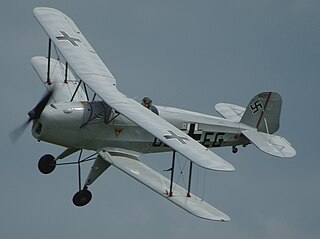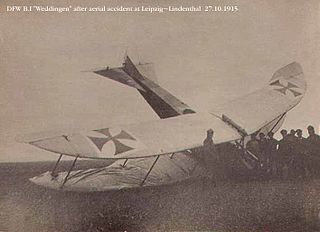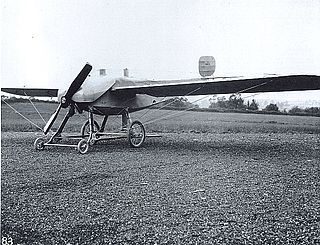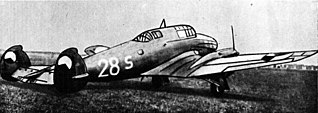
The Bücker Bü 131 Jungmann was a German 1930s basic training aircraft which was used by the Luftwaffe during World War II.

The Etrich Taube, also known by the names of the various later manufacturers who built versions of the type, such as the Rumpler Taube, was a pre-World War I monoplane aircraft. It was the first military aeroplane to be mass-produced in Germany.

The Aero A.14 was a Czechoslovakian biplane military reconnaissance aircraft built in the 1920s. It was essentially a slightly modified version of the Hansa-Brandenburg C.I aircraft that Aero had built during World War I as the Ae.10, and for this reason, the aircraft is sometimes referred to as the A.14 Brandenburg. When equipped with a slightly different engine, the aircraft was designated A.15 instead. The two versions were otherwise almost identical.

The Taube was first constructed in 1909-1910 by Austrian Igo Etrich and later developed into a two-seater military aircraft in 1912. Many Taubes were built under licence by a wide array of manufacturers but most were produced by the Rumpler Flugzeugwerke. By 1912 the design had evolved to a 2-seater reconnaissance aircraft for military use

Ignaz "Igo" Etrich, Austrian flight pioneer, pilot and fixed-wing aircraft developer.

The DFW B.I, was one of the earliest German aircraft to see service during World War I, and one of the numerous "B-class" unarmed, two-seat observation biplanes of the German military in 1914, but with a distinctive appearance that differentiated it from contemporaries. Though a biplane, its crescent-planform three-bay wings were inspired by that of the earlier Rumpler Taube monoplane, and led to the DFW aircraft being named the Fliegende Banane by its pilots.

The Bristol Coanda Monoplanes were a series of monoplane trainers designed by the Romanian designer Henri Coandă for the British company British and Colonial Aeroplane Company.

The Bücker Bü 180 Student was a 1930s German two-seat sporting/training aircraft built by Bücker Flugzeugbau.
Flugwerk Deutschland GmbH was a German aircraft manufacturer based in Brand, a district of Aachen.

The Ryan S-C (Sports-Coupe) was an American three-seat cabin monoplane designed and built by the Ryan Aeronautical Company. At least one was impressed into service with the United States Army Air Forces as the L-10.
The Bücker Bü 134 was a German single engine, high wing cabin monoplane prototype designed and built by Bücker Flugzeugbau GmbH.
Etrich Flugzeugwerke (EFW) was a short-lived aircraft manufacturer founded by Igo Etrich.

The Avia B.158 was a prototype Czechoslovak twin-engined light bomber aircraft of the 1930s. Only a single example was built and it was abandoned, following the German occupation of Czechoslovakia in March 1939.

The Nieuport IV was a French-built sporting, training and reconnaissance monoplane of the early 1910s.

The Cody V was a single-engined biplane built by the British-based American aviation pioneer Samuel Franklin Cody in 1912. It was built from the remains of two of Cody's earlier aircraft, and won the 1912 British Military Aeroplane Competition, with two aircraft being purchased for the Royal Flying Corps. It was abandoned after the mid air disintegration of one of the aircraft in April 1913.

The Cody IV monoplane was a single-engined monoplane designed and built by the American-born but British-based aviation pioneer Samuel Franklin Cody in 1912. It was intended for entry into the 1912 British Military Aeroplane Competition, but was wrecked in a crash before the start of the competition.
The Airdrome Taube is an American amateur-built aircraft, designed and produced by Airdrome Aeroplanes, of Holden, Missouri. The aircraft is supplied as a kit for amateur construction.

The Volksflugzeug was a grand Third Reich scheme for the mass-production of a small and simple airplane in the 1930s. It was one of the attempts of the Nazi regime to use consumer technologies as a propaganda tool. Unlike the Volkswagen car, the showpiece of the Nazi's attempt to appear to work for the good of the average German, as well as the less-known Volksempfänger radio, the Volkskühlschrank refrigerator and the Volksgasmaske gas mask, the Volksflugzeug project was contemplated but never fully realized.

The Luft-Limousine or Luftlimousine, also known as Etrich VIII Luft-Limousine, was a single engine monoplane built by the Etrich company in Silesia in 1912.















